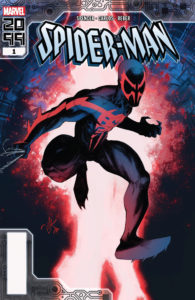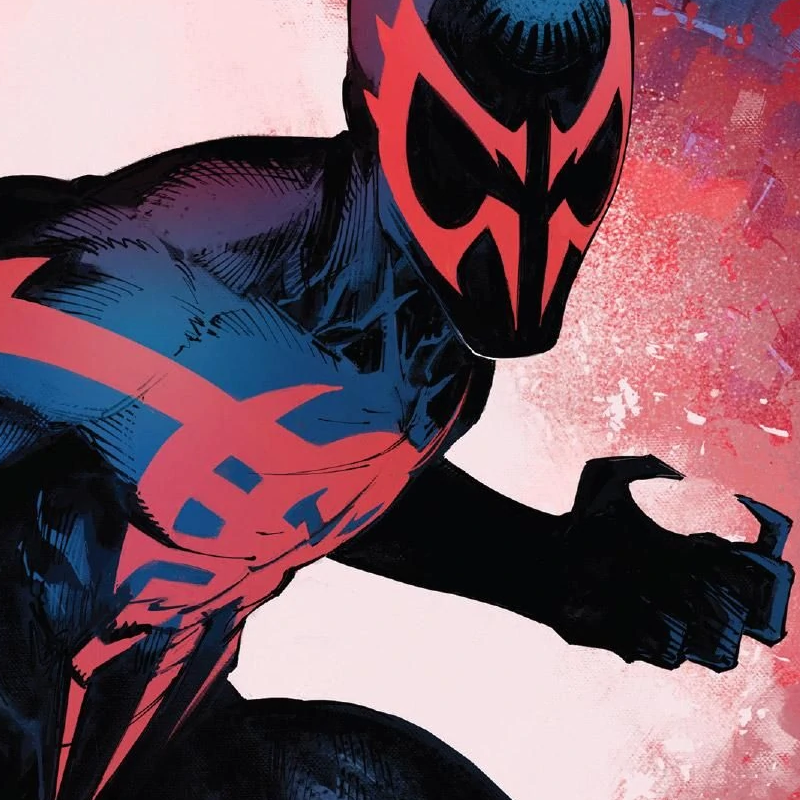Writer: Nick Spencer 
Artist: Zé Carlos
Colorists: Brian Reber with Andrew Crossley
Letterer: VC’S Cory Petit
Cover Artist: Viktor Bogdanovic
Editor: Nick Lowe
Publisher: Marvel Comics
Of all the characters created for the 2099 setting, Miguel O’Hara — Spider-Man 2099 himself — is probably the most known and beloved. After showing up in various cartoons and video games over the past decade or so, he made his big screen debut as a post-credits cameo in Spider-Man: Into the Spider-Verse (voiced by Oscar Isaac) and will likely play a larger role in the upcoming sequel, so it makes sense that Marvel would want to boost awareness of his character both on and off the page. That being said, I’m not sure this one-shot is going to do much to elevate Miguel to A-List status.
Spinning out of the current 2099 crossover event that started in Nick Spencer’s Amazing Spider-Man, Marvel recently made a point of saying the 2099 is no longer a possible future, but the definitive future of the Marvel Universe moving forward. That’s an interesting gambit on a logistical level; can Marvel really commit themselves to just one future that’s still so far away from happening? DC is infamous for having this sort of problem and overcorrecting their timeline inconsistencies, which inadvertently creates an endless loop of retcons and reboots that even their most ardent followers can get confused by. Despite Marvel saying 2099 is the future of the MU, I think it would probably be wise to take that claim with a grain of salt.
In any event, this issue of Spider-Man 2099 seems to be restating Miguel’s superhero origin for the new, “definitive” future timeline that would allow them to continue with a clean slate. With the original iteration of the character ceasing to exist in the leadup to 2099, Miguel’s history has been rebooted in slight ways. His classic origin is that he’s a geneticist working at all-encompassing Alchemax corporation (which basically runs the United States in 2099) and gains spider-like powers from a drug in a botched murder attempt, ultimately becoming the new Spider-Man. In this version of events, however, he voluntarily took the drug that gives him powers … or rather, will give him powers.
The weird thing about Spider-Man 2099 #1 is that Miguel never actually wears the suit himself at any point, nor do we get an inkling of him having superpowers at all. We do see glimpses of a Spider-Man, but it’s not made clear if there’s someone really kicking around as Spidey, or if they’re a vision he’s having from nightmares. And if things couldn’t get more complicated, Miguel is faced with a not-so-familiar face claiming to be very familiar with him.
Maybe it’s just because I haven’t been especially keeping up with Spencer’s 2099 or Amazing, but the entire issue in general comes off just a bit confusing. The timeline of events presented within are somewhat all over the place, with little visual distinction making it clear when something is happening without referring to the narration. There’s nothing wrong with Spencer’s script, strictly speaking, but it probably could have done with a few more edits and clarification. The final page tells us this plot will continue in the 2099 omega issue, but I feel as though this tie-in could’ve benefited from being its own mini-series before wrapping up in the main 2099 finale. I don’t see how this one-shot, let alone the various other ones (Doom 2099, Punisher 2099, etc.) will end satisfactorily in the omega issue with such little space to explore those concepts.
While I’m not a fan of the way the story is presented here, I can’t fault Zé Carlos’s art, which provides some solid superhero action but also sells what Spencer has written on the page. I just wish he had more of an opportunity to draw the 2099 suit, which is obviously a cool-looking design that barely shows up in the issue. I’d also like it if the settings of 2099 looked more “futuristic” than they actually do, which is less Carlos’s problem and more likely an editorial mandate for visual consistency across all the 2099 tie-ins.
Because the world of 2019 isn’t that far off from what the creative minds of 1992 predicted what 2099 would be like, you could plausibly read this comic and not even realize it’s meant to be set eighty years from now. Even if lots of the tech seen here may not necessarily exist in our real world yet, they’re fairly commonplace in the Marvel Universe (e.g. holographic A.I. systems that walk and talk like people). If we’re going to believe this is the far future, the art direction of the world needs to convey that, which I don’t think this does. Even a change in coloring would help; Spider-Gwen’s unique neon-powered palette, for example, did a lot of the heavy lifting to demonstrate how that reality was different from ours. Brian Reber and Andrew Crossley’s colors are fine, but they feel a bit too grounded for the material they’re working with.


![[OPINION] TO BIG HOLLYWOOD GO THE SPOILS; OR SOME REASONS WHY ENDGAME LEAKS ARE A GOOD THING](https://geekd-out.com/wp-content/uploads/2019/04/avengers-endgame-poster-closeup-150x150.jpg)

